Goa Travel Guide
For travellers yearning to enjoy spectacular sunsets, paradise beaches, a laid-back lifestyle, great market shopping sprees, and full-moon parties, Goa is the place to visit:
Goa is celebrated globally as a destination for hedonists, beach bums and hippies, but this beautiful state now attracts people of all kinds to holiday on its picturesque shores. Families and millionaires are as likely to be seen there as backpackers. The big drawcard is Goa's beaches, but there is fun to be had beyond the golden sands.
Goa was a Portuguese colony until 1961 and the state's natural bounty is complemented by the colonial splendour of Old Goa and parts of Panaji. There are many temples and churches of note to explore for holidaymakers who can drag themselves from the beach. Goa also offers interesting cuisine, fabulous shopping opportunities and, of course, some seriously good parties. There is no disputing that Goa's nightlife is the best in the country, and it is a dream destination for lovers of trance music.
Best time to visit Goa
Goa is uncomfortably hot and humid during summer, and the monsoon rains arrive between June and September. Therefore, the best time to visit Goa is during the state's short winter, between November and February, which just happens to coincide with the extremely popular New Year's celebrations. October and March are good months to visit to avoid the crowds and the parties as well as the worst of the heat, but many facilities will be closed.
What to see in Goa
-Explore the colonial splendour of Old Goa, a UNESCO-listed site.
-Visit the Dr Salim Ali Bird Sanctuary and explore the mangroves.
-Take an excursion to the Dudhsagar Waterfall, and enjoy the views.
-Enjoy the unspoiled beach paradise Palolem.
What to do in Goa
-Shop for souvenirs at the renowned Anjuna Flea Market, before hitting the beach.
-Go swimming at the picturesque Baga Beach.
-Trawl the bars, shops and restaurants at Calangute Beach.
-Stroll through the cobbled streets of the state capital, Panaji.
Beyond Goa
Many visitors choose to combine a Goan beach holiday with the urban delights and challenges of the city of Mumbai. Mumbai and Panaji are joined by a quick rail link making this trip easy. Another nearby city with many worthwhile attractions is Bengaluru, and some choose to travel all the way south to enjoy the beauty of Kerala and Kochi.
Getting there
Also known as Dabolim Airport, Goa International Airport is the only airport in the state of Goa, and provides a gateway to the state's exotic beaches and spectacular temples. The airport is located 18 miles (about 29km) southwest of Panaji.
Did you know?
-Goa is the smallest state in India.
-The first printing press and the first medical school in India were in Goa.
-Though the smallest state in India, Goa has more than 6,000 bars (nearly two per square kilometre).
Things to do in Goa
Goa boasts a number of great attractions for visitors to enjoy while on holiday. This area is of course famous for its gorgeous beaches, but there are many splendid historical sites to see in Old Goa. Visitors can also explore colonial architecture in Margao and Panaji, and browse a vast flea market in Anjuna. The Dudhsagar Waterfall and Dr Salim Ali Bird Sanctuary are popular as well.
The stunning beaches are Goa's most renowned features, though, and visitors will have many excellent options to choose from. Anjuna Beach was once a famous hippie hangout but, today, this beautiful stretch of palm-lined sand has become popular with tourists of all kinds. Baga Beach is great for swimming and a little less crowded than Anjuna, but no less picturesque. Calangute is the busiest and the most commercial beach and, although it is not as lovely as some of the others aesthetically, visitors will enjoy exploring the beach bars, restaurants and shops. Colva is a developed resort area and somewhat blighted by all the hawkers, hotels and hangers-on. However, visitors who walk just a little way can still find beauty and peace along this stretch. Palolem Beach, in the south, is the most unspoilt and natural of Goa's popular beaches, and has retained its laid-back and secluded charm.
The local food is another major attraction as it blends Portuguese and Goan flavours, setting it apart from all other culinary traditions around the country. Goan cuisine is known for delicious fiery flavours, fresh-caught seafood, and an abundance of coconut. Travellers should make a point of trying the state's signature dish, Vindaloo: a mouthwatering, super-hot meat curry made with palm vinegar and dried red chilli peppers.
Although still known as India's party paradise, Goa is a wonderful, relaxing destination to visit with kids on holiday. Children will love the variety of things to see and do, be it renting a bike to explore the local area, catching a boat for some swimming and dolphin watching, or simply enjoying the beaches. Visitors should note, however, that although some hotels or guesthouses may offer childcare services, and this may be tempting, it is strongly advised that they keep their children with them at all times while in a foreign country.
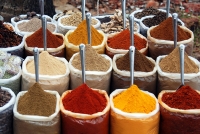
Anjuna Flea Market
Once just a backpacker and hippie hangout selling kaftans and chillums, the Anjuna Flea Market is now more commercial, with a broad range of high-quality goods on sale. Traders from all over India come to sell their wares: Lamani women from Karnataka, dressed in their traditional garb, sell colourful, elaborately woven clothes; Kashmiri stalls display silver and papier-mâché boxes; and Tibetans preside over orderly rows of sundry Himalayan curios. Visitors are expected to bargain but the stall owners tend to be friendly and less pushy than in some other markets.
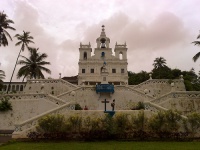
Panaji
This most sedate of state capitals has plenty to offer tourists, and should rightly have a day or two devoted to it on any Indian travel itinerary. Situated on the southern banks of the Mandovi River, Panaji only became the capital of Goa in 1843, after the harbour at Old Goa silted up and disease had driven its inhabitants out. The best way to explore the town is on foot, wandering around the old cobbled alleyways, colonial villas, red-roofed houses, taverns and cafes, all of which create the look and feel of a small Portuguese town.
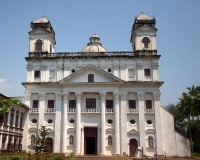
Old Goa
Old Goa was the state's capital city until 1843, when it was moved down river to Panaji. Once a byword for splendour, with a population of several hundred thousand, Old Goa was virtually abandoned from the 17th century, as the river silted up and a series of malaria and cholera epidemics drove out the inhabitants. It takes some imagination to picture the once-great capital as it used to be. The maze of twisting streets, piazzas and grand Portuguese villas have long gone. All that remains are a score of extraordinarily grandiose churches and convents. Old Goa has been declared a UNESCO World Heritage Site, and today is the state's main cultural attraction.
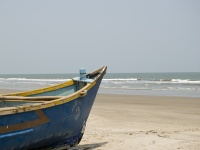
Goa Beaches
Goa has some amazing beaches, and draws a steady stream of local and international tourists. In the north, Anjuna Beach once played host to hordes of hippies, but is now home to a number of trendy beach bars as well as the famous Wednesday Market. The new hippie haven, Arambol beach, is also good for dolphin viewing and paragliding. With its white-sand beaches, Agonda in the south is a quiet stretch of beach with a few souvenir stalls and restaurants, while Benaulim Beach, south of Colva, is known for its fishing and laid-back atmosphere. The shady palm trees and soft sands of Palolem Beach, also known as Paradise Beach, are backpacker territory.
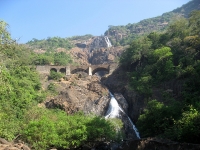
Dudhsagar Waterfall
A great outing in Goa is a trip to the Dudhsagar Waterfall, which is one of the most popular natural attractions in the area. The falls are located in a tropical jungle near the Goa-Karnataka border, and are surrounded by a network of gently flowing streams and pools. Swimming, hiking and picnicking are popular pastimes at the falls and the deep pool beneath the falls is a favourite nature spot. The waterfalls are among the 100 highest in the world, and visitors who take the difficult climb to the top will be rewarded with breathtaking views of the Western Ghats' wooded mountains.
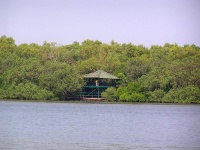
Dr Salim Ali Bird Sanctuary
The Dr Salim Ali Bird Sanctuary is home to around 400 species of birds, both local and migratory. Here visitors can expect to see kingfishers, pintails, coots and egrets, as well as a few crocodiles, jackals and foxes inhabiting the mangroves. Although this is one of the smallest bird sanctuaries in Goa, it is among the most famous in India. It is important to go at the right time of year, with the best time to see the migratory birds being after the monsoon season, from October to March. Bird and animal sightings are likely to be better early in the morning.
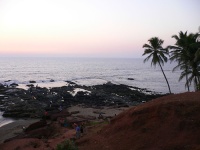
Anjuna
Famed as a hippie hangout since the 70s, the main source of Anjuna's enduring popularity as a holiday destination is its superb beach. Fringed by palm trees, the curve of soft white sand conforms more closely to the archetypal vision of paradise than any other beach on the north coast. The quieter southern end is protected by rocky outcrops, while to the north the beach widens and stretches for almost a mile past groups of bars, cafés and handicraft stalls. Revellers from the UK and all over India come to Anjuna on holiday, lured by the club scene and the promise of big beach parties (particularly over Christmas and New Year).
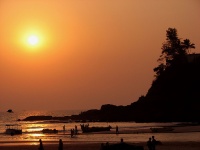
Baga Beach
The Baga Beach holiday resort is a few miles south of Anjuna, and is basically an extension of Calangute. Lying in the lee of a rocky, wooded headland, the only difference between this far northern end of the beach and its more congested centre is that the scenery here is marginally more varied and picturesque, and the beach less crowded. It is a good swimming beach but there are no promising breaks for surfers. However, there are lots of other watersports on offer. Hawkers can be an irritation but no more than on most other popular stretches of sand in Goa; a firm 'no' usually does the trick.
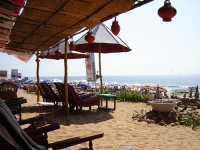
Calangute Beach
Once a peaceful fishing village and then a haven for hedonistic hippies, Calangute is now Goa's busiest and most commercialised holiday resort, a 45-minute bus ride north of the capital, Panaji. The road from the town to the beach is lined with Kashmiri-run handicraft boutiques and Tibetan stalls selling Himalayan curios and jewellery. The quality of the goods (mainly Rajasthani, Gujarati and Karnatakan textiles) is generally high, but visitors should haggle hard and without being afraid to walk away (the same stuff will crop up again and again). The Calangute beach is nothing special, but is more than large enough to accommodate the huge numbers of holiday visitors.
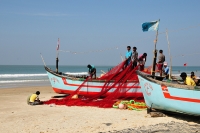
Colva
Colva is the oldest and most heavily developed South Goan holiday resort. The town itself is dotted with colonial-style villas and ramshackle fishing huts, but the beachfront is crowded and blighted with unimaginative concrete hotels, snack bars and souvenir stalls. However, it is easy to steer clear of this central area as a spotless and relatively quiet beach is a few minutes' stroll away. Benaulim is only a 30-minute walk to the south, still on Colva beach, and attracts a more upmarket clientele, including British and Indian visitors on holiday. There are many luxury resorts along the coastal stretch, and brightly painted wooden fishing boats litter the beach.
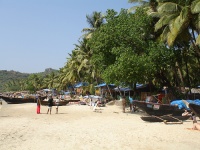
Palolem
For years Palolem remained a secret holiday getaway to all but the most independent traveller. Situated towards the southern tip of Goa, twenty miles south of Margao, it has now been discovered, though thankfully, due to strict urban planning restraints, tourism is kept in check. Palolem's crescent-shaped bay is lined with a beautiful white-sand beach and backed with groves of coconut palms. Either side of the bay is a rocky headland covered in thick black forest, and offshore there is a tiny island whose only permanent inhabitants are a colony of black-faced langur monkeys.
Shopping
There's great shopping to be done in Goa, with the most popular shopping spots being in Panaji and Anjuna. The quintessential Goan souvenirs are azulejos, Portuguese-style tiles and ceramics that have been beautifully hand-painted, but there is a huge selection of fine and funky goods in the markets, and it is easy to see that Goa still caters to the hippie crowd when exploring the shops. Sometimes the outdoor markets have a carnival atmosphere, with musicians and entertainers performing around the stalls. Tourists will be expected to bargain in the Goan markets; a good rule of thumb is to try and barter the price down to half of the original. Visitors should remember that most goods will be offered by multiple stalls, so they shouldn't be scared to walk away and compare prices.
The Anjuna Wednesday market has everything from trendy rave gear to comfy hammocks; while semi-precious stones, paintings and local crafts are available from the Ingoe and Mackie night bazaars. The Mapusa Friday Market is good for freshly baked Goan breads, homemade pork sausages and an assortment of pickles.
In Calangute, the Casa Goa boutique offers local designer wear, artwork and silk drapes, and tribal art is available from the nearby Leela Art Palace. Travellers can visit Sangolda for rattan loungers and Rajasthani chests. There are also stunning lampshades available at Soto Décor.
Nightlife
Flaunting its strong Portuguese heritage, Goa is definitely the nightlife hub of India. Goa still retains a laid-back hippie atmosphere in many areas and impulsive beach parties are a common occurrence, with visitors and locals relaxing on the beach after sunset with a couple of cold drinks and some mellow tunes. There are also numerous houses that have a room open to the public as a bar-cum-restaurant, usually serving great seafood.
Goa hosts great rave and trance music parties, especially in winter under the full moon. The venues for these raves are kept secret till just hours before they kick off, and visitors will have to ask around at local bars for details. Goa is also developing fast as a resort centre and many hotels provide their own party venues. The most famous Goan party season is over New Year's Eve, when visitors flood onto the beaches to dance under the stars and enjoy fireworks and trance music in this beautiful setting. If visitors travel to Goa for a new year's party, they should be sure to book far in advance as it is very popular.
Travellers should note that over the past few years, authorities have been cracking down on the Goan party scene, closing numerous bars and passing new liquor laws. Much fun can still be had in the state, but it is a good idea to get familiar with the laws before travelling, as state legislature is somewhat up in the air at the moment.
Getting Around
A wide variety of transport is available in Goa. Most tourist sights can be accessed by road and there are buses, rental cars, taxis and scooters available for travellers to use. The best (and the most fun) way to get around Goa is to hire a motorcycle, but travellers should be sure to carry the necessary paperwork (licence, registration and insurance) because checks on foreigners are a lucrative source of 'baksheesh' for the Indian police force. Roads and attractions are not well sign-posted, so travellers shouldn't hesitate to ask for directions. Accident and fatality rates on Goan roads have been high in the past, so it pays to be cautious. Local buses stop at the main beaches.
Auto-rickshaws are also a popular transportation option, and are available in town and from the airport, railway station and bus terminus. When taking taxis or rickshaws, visitors should be sure to negotiate a fare before setting out to avoid being overcharged or having an argument. Goa is generally easy to get around and public transport is not expensive. As most visitors choose to stay near or on the beach front, limited transport is needed on a daily basis because restaurants, shops and attractions tend to be in walking distance.
Goa Climate and Weather
Goa has a tropical climate, with hot, humid weather for most of the year. In summer the temperatures can reach as high as 91F (33C) and there are monsoon rains from June to September. Goa has a short winter, lasting only from December to February, with temperatures averaging around 77F (25C).
The best time to visit Goa is during the cooler months between November and March, when the weather is warm, there is no rain, and the seas are calm and clear. The most popular time to visit Goa is over December and January, partly because the weather is ideal at this time, but also because Goa is renowned for its Christmas and New Year's celebrations. October, at the very start of the tourist season, is a good month to visit in if travellers want to avoid the worst of the crowds but, although the beaches will be lovely and empty, many facilities will be closed and it'll be harder to find open restaurants and shops. March or early April are also good times to arrive, as it isn't quite as busy and not yet very hot.
India travel info
Electricity
230 volts, 50Hz. A variety of power outlets are used in India, but most plugs have two or three round pins.
Language
India has a total of 22 official languages, including English and Hindi. Hindi is spoken by about 40 percent of the population; Urdu is the language common with the Muslim demographic.
Money
The currency is the Indian rupee (INR), which is divided into 100 paise (singular paisa). Major currencies can be changed at banks, and authorised bureaux de change. It is illegal to exchange money through the black market and it is advisable to refuse torn notes, as no one will accept them apart from the National Bank. It is best to change money into small denominations. Major credit cards are widely accepted, particularly in tourist orientated establishments. ATMs are available in large cities and airports but are not generally available in rural areas.
Tipping
Taxi drivers do not expect to be tipped, though it's standard to leave a gratuity for porters, guides, hotel staff and waiters in small establishments. A 10 percent service charge is often added to bills in tourist restaurants or hotels. 'Baksheesh' is common in India. It's more a bribe than a tip and is given before rather than after service.
Health
There are many health risks associated with travel to India. Although no vaccinations are required for entry into the country, travellers should take medical advice on vaccinations at least three weeks before departure. Outbreaks of dengue fever and chikungunya virus occur, and Malaria is common, particularly in the northeast of the country. Outbreaks of cholera occur frequently. Travellers coming to India from an infected area should hold a yellow fever certificate. Rabies is also a hazard; travellers should get immediate medical advice if bitten.
Food poisoning is the most common problem among travellers to India. Visitors should only drink bottled water and ensure that the seal on the bottle is intact. Travellers should avoid ice, as it's often made from tap water. Meat and fish should be eaten with care in all but the best restaurants, and should always be well cooked and served hot. Salads and unpeeled fruit should be avoided.
Health facilities are adequate in the larger cities, but limited in rural areas. Travellers should have comprehensive medical insurance, and carry a small first-aid kit complete with a traveller's diarrhoea kit and a course of general antibiotics.
Safety
Although the vast majority of trips to India are trouble free, there are some risks that travellers should be aware of. As in many countries, there is a threat of terrorism; in the past there have been attacks in popular tourist haunts such as hotels, markets and temples. Travellers should take caution at large religious events, where huge crowds can result in life-threatening stampedes.
On a more everyday level, there is a risk of minor theft such as pick-pocketing, and credit card and ATM fraud occurs. Travellers using India's vast railway network are advised to lock their baggage, and keep it close. Visitors should remember that if someone offers them a 'business opportunity' that seems too be good to be true, it probably is. Scammers usually target foreigners at airports and in tourist areas with scams involving the exportation of, among other things, jewels, gemstones, carpets. Taxi drivers may offer them money to export such items.
Female travellers should note that there are rare incidents of rape and assault. Women should respect local dress codes and customs, and avoid travel to secluded rural areas, including beaches, at any time of day. Foreign offices advise against travel to Jammu and Kashmir, as there are risks of civil disorder and acts of terrorism in many districts.
Local customs
India is a tolerant society, but visitors should educate themselves about the country's religious and social customs so as not to cause offence. In this regard, smoking in public is banned, and there is a ban on e-cigarettes and related products. Consumption of alcohol is prohibited in Bihar, Gujarat, Mizoram, Nagaland and the union territory of Lakshadweep; there is a partial ban in parts of Manipur.
When visiting temples, visitors will probably be required to remove their footwear and cover their heads. Generally, women should dress more conservatively than they may be used to doing at home, both to respect local sensibilities and to avoid unwanted attention. Topless bathing is illegal. Indians do not like to disappoint and, often instead of saying 'no', will come up with something that sounds positive, even if incorrect. Social order and status are very important in Indian culture, so it's important to remain respectful and obliging with elders. Visitors should avoid using their left hand, particularly when eating. Although homosexuality is no longer prohibited by law, Indian society remains conservative and public attitudes towards LGBT people can less tolerant than in the west.
Doing business
Business in India is conducted formally, with punctuality an important aspect. Suits and ties are appropriate, and women in particular should dress modestly. If it is very hot, jackets are usually not required and short-sleeve shirts are deemed appropriate. It is customary to engage in small talk before getting down to business, and conversation can cover a wide range of topics that may include anything from cricket to politics. Business cards are usually exchanged on initial introduction, using the right hand only. Handshakes are fairly common, though one should wait to see if greeted with a hand, or a 'namaste': a traditional Indian greeting of a small bow accompanied by hands clasped as if in prayer. Visitors should return the greeting as it is given. It is common for women to participate in business meetings, and hold high positions in companies, and foreign businesswomen are readily accepted. Business hours are usually from 9.30 to 5.30pm (weekdays) with a lunch break from 1pm to 2pm, and Saturdays from 9.30am to 1pm.
Duty free
Travellers to India over 18 years do not have to pay duty on 100 cigarettes or 25 cigars or 125g tobacco; two litre bottle of alcohol; medicine in reasonable amounts; and goods for personal use. Prohibited items include livestock, bird and pig meat products, and e-cigarettes.
Communications
The international access code for India is +91. International calls are expensive and there are often high surcharges on calls made from hotels. Buying a local SIM card is a good option, as international roaming fees can be high. Free WiFi is offered at cafes and hotels in major cities.
Passport & Visa
Indian law does not permit dual citizenship for nationals of India. An Indian national holding dual nationality should contact their embassy or consulate for further information. Passengers in possession of an "Overseas Citizen of India" card or a "Person of Indian Origin" card, however, are allowed to enter the country without a visa.
Travellers should note that a yellow fever vaccination certificate is required, if arriving in India within six days of leaving or transiting through heavily infected areas.
They should also note that the following areas of India are restricted, and require that visitors obtain a permit before entering them: (Protected Areas) parts of the state of Manipur, parts of the state of Mizoram, parts of the state of Arunachal Pradesh, parts of the state of Uttar Pradesh and Uttarakhand, the whole State of Sikkim, parts of the state of Jammu and Kashmir, parts of the state of Himachal Pradesh; (Restricted Areas) the whole of the union territory of Andaman and Nicobar Islands, part of the state of Sikkim.
It is highly recommended that travellers' passports have at least six months' validity remaining after the intended date of departure from their travel destination. Immigration officials often apply different rules to those stated by travel agents and official sources.
Entry requirements
US citizens must have a passport that is valid for their six months beyond the date of their visa application. A visa is required, except for passengers with a Person of Indian Origin (PIO) or Overseas Citizen of India (OCI) card or booklet. E-visas can be obtained online before departure. Passengers using the e-visa for the first time must have a passport with at least two unused visa pages, and printed confirmation of the Electronic Travel Authorisation (ETA).
UK citizens must have a passport that is valid for at least six months from their date of entry into India. A visa is required, except for passengers with a Person of Indian Origin (PIO) or Overseas Citizen of India (OCI) card or booklet. E-visas can be obtained online before departure. Passengers using the e-visa for the first time must have a passport with at least two unused visa pages, and printed confirmation of the Electronic Travel Authorisation (ETA).
Canadian citizens must have a passport that is valid for six months from their date of entry. A visa is required, except for passengers with a Person of Indian Origin (PIO) or Overseas Citizen of India (OCI) card or booklet. E-visas can be obtained online before departure. Passengers using the e-visa for the first time must have a passport with at least two unused visa pages, and printed confirmation of the Electronic Travel Authorisation (ETA).
Australian citizens must have a passport that is valid for six beyond their date of entry. A visa is required, except for passengers with a Person of Indian Origin (PIO) or Overseas Citizen of India (OCI) card or booklet. E-visas can be obtained online before departure. Passengers using the e-visa for the first time must have a passport with at least two unused visa pages, and printed confirmation of the Electronic Travel Authorisation (ETA). Australian citizens can apply for visas online before travel provided they have a printed copy of the e-Toursit visa confimation that was applied for online, a passport containing at least two unused visa pages, and return or onward tickets.
South African citizens must have a passport that is valid for six months beyond their date of entry. A visa is required, except for passengers with a Person of Indian Origin (PIO) or Overseas Citizen of India (OCI) card or booklet. E-visas can be obtained online before departure. Passengers using the e-visa for the first time must have a passport with at least two unused visa pages, and printed confirmation of the Electronic Travel Authorisation (ETA). South African citizens can apply for visas online before travel, provided they have a printed copy of the e-Toursit visa confimation that was applied for online, as well as a passport containing at least two unused visa pages.
Irish citizens must have a passport that is valid for six months beyond their date of entry. A visa is required, exept for passengers with a Person of Indian Origin (PIO) or Overseas Citizen of India (OCI) card or booklet. E-visas can be obtained online before departure. Passengers using the e-visa for the first time must have a passport with at least two unused visa pages, and printed confirmation of the Electronic Travel Authorisation (ETA).
Citizens of New Zealand must have a passport that is valid for six months beyond their date of entry. A visa is required, exept for passengers with a Person of Indian Origin (PIO) or Overseas Citizen of India (OCI) card or booklet. New Zealanders can apply for visas online before travel provided they have a printed copy of the e-Tourist visa confirmation that was applied for online, a passport containing at least two unused visa pages, and return or onward tickets; e-Tourist visas can only be issued a maximum of two times per calendar year.
Useful contacts
Indian Tourist Office, New Delhi: www.incredibleindia.org
100 (Police), 102 (Ambulance), 101 (Fire)Embassies / consulates in other countries
Indian Embassy, Washington DC, United States: +1 202 939 7000.
Indian High Commission, London, United Kingdom: +44 (0)20 7836 8484.
Indian High Commission, Ottawa, Canada: +1 613 744 3751/52/53
Indian High Commission, Canberra, Australia: +61 (0)2 6225 4900.
Indian High Commission, Pretoria, South Africa: +27 (0)12 342 5392.
Indian Embassy, Dublin, Ireland: +353 (0)1 496 6787.
Indian High Commission, Wellington, New Zealand: +64 (0)4 473 6390/1.
Embassies / consulates in India
United States Embassy, New Delhi: +91 (0)11 2419 8000.
British High Commission, New Delhi: +91 (0)11 2419 2100.
Canadian High Commission, New Delhi: +91 (0)11 4178 2000.
Australian High Commission, New Delhi: +91 (0)11 4139 9900.
South African High Commission, New Delhi: +91 (0)11 2614 9411.
Irish Embassy, New Delhi: +91 (0)11 4940 3200.
New Zealand High Commission, New Delhi: +91 (0)11 2688 3170.



